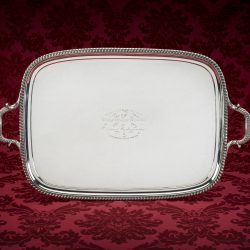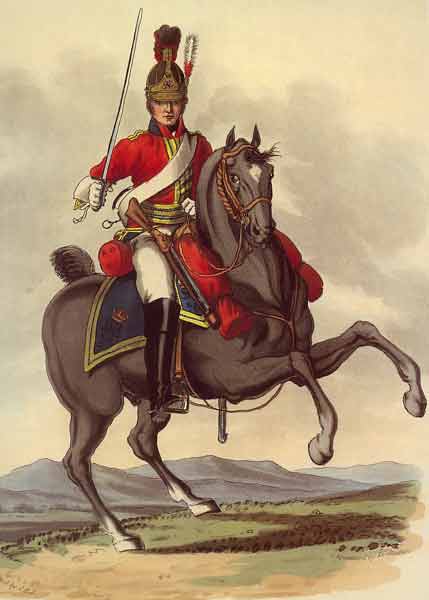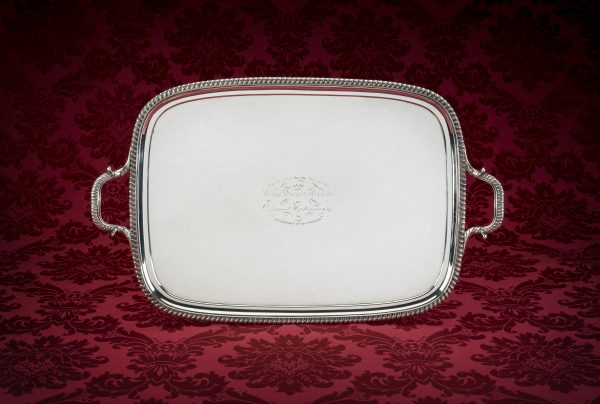Battle of Waterloo Prize Money Silver Tray

FINE AND RARE GEORGE III TWO HANDLED SILVER PRESENTATION TRAY BY WILLIAM BATEMAN, LONDON 1816.
plain with gadroon edge and leaf capped gadroon handles, centre engraved with presentation inscription:
PRESENTED by the OFFICERS
of the
KING’S DRAGOON GUARDS
to
Edmund Hopkinson Esqr
in
Testimony of their esteem
Dimensions: 580mm x 370mm / 23 1/2″ x 14 1/2″
This silver tray was presented by the surviving officers of the King’s Dragoon Guards to their army agent Edmund Hopkinson after the battle of Waterloo . Raised in 1685, the King’s Dragoon Guards (which continues today as 1st The Queen’s Dragoon Guards) is the oldest cavalry line regiment in the British Army.
The KDG had remained in England during the Napoleonic Wars but following Napoleon’s return from Elba in April 1815 four squadrons or eight troops of the regiment (consisting of 27 officers and 505 troopers) led by Lieutenant Colonel William Fuller were ordered to join the Allied army assembling under the duke of Wellington’s command in Belgium.
On arrival, they were brigaded with the Life Guards and Royal Horse Guards (the Blues) under Major General Lord Edward Somerset to form the Household Cavalry Brigade. With the Union Brigade of Greys, Royal Dragoons and Inniskillings under Major General William Ponsonby; they completed the heavy cavalry division of the army under the overall leadership of the Marquess of Uxbridge.

After two months of reviews and preparations bivouacked in the Dender Valley, early on 16 June the brigade was ordered to Quatre Bras but arrived too late for the costly but indecisive action there between Wellington’s vanguard and Napoleon’s advancing army. The next day the KDG covered the army as it fell back to Waterloo, near Brussels, where Wellington had resolved to stand and face Napoleon. Several times during the withdrawal, the KDG and other heavy cavalry units charged the French as they pursued the allied infantry up the road.
On the morning of 18 June, the heavy cavalry formed up in the centre of the British position about 200 yards behind the infantry and the ridge of Mont St Jean. The KDG were in the front rank of the Household Brigade, to the right of the Brussels road. There they waited until about 1.30pm when Napoleon, frustrated in his efforts to secure Hougoumont farm, launched 4 divisions of troops supported by an artillery barrage and a brigade of Cuirassiers at the heart of the allied line. At this critical moment, Uxbridge unleashed the heavy cavalry: the Union brigade tore into the French infantry whilst the KDG and Life Guards swept down and met the Cuirassiers full on.
The impact of the charge had devastating consequences – for both sides. The KDG charge was split by the buildings at La Haye Sainte and in the mad confusion which followed, men and horses became disorientated and ill-disciplined, some galloping straight through the French lines to become isolated and easy prey for the Cuirassiers to pick off. Five of the KDG’s eight troops were wiped out and six officers killed or missing, including Colonel Fuller. But the charge was a body blow to Napoleon: stopping his advance and scattering the Cuirassiers. As the exhausted horsemen returned to the British lines, an officer of the Royal Dragoons called for them to rally on him only to be hear the defiant reply: “We are King’s Dragoon Guards – not Royals”.
After a lull, the French unleashed wave upon wave of cavalry against the British centre, forcing the infantry into squares whilst the remnants of the British heavy cavalry repeatedly counter charged. By six, the entire Household Brigade was down to about 100 men and horses. The Union Brigade had fared no better so the two brigades joined up and rallied in a final and desperate show of strength, their horses blown and subjected to constant artillery and musket fire they watched as the battle reached its crisis point.
All seemed lost but slowly more and more Prussian troops arrived on the British left, releasing British divisions to bolster Wellington’s fragile centre until, imperceptibly at first then in a rout, the French left turned, crumbled and fled chased by the exhausted remnants of the heavy cavalry. The battle was won but at appalling cost for the KDG. Out about 530 KDG who had paraded that morning only 15 were still in action at the end of the day. Others – wounded or lost on the battlefield – eventually made their way back but the losses were still terrible: 129 killed and 134 wounded. In addition, 269 horses were killed.
The dead included 7 of the KDG’s 26 officers. It was these survivors who, on their eventual return to England in May 1816, presented this silver tray to their banker and army agent Edmund Hopkinson (1787-1869), of Hopkinson and Sons, St James’s probably for arranging the distribution of prize money after the battle. This was a sum of money awarded to soldiers of the British Army after victories, paid from the value of captured enemy property.
The money was a reward, but it was also meant to encourage soldiers to fight aggressively and force the enemy to flee and abandon their possessions. Dividing the money amongst all the soldiers helped discourage individuals from looting in the middle of the battle – although this undoubtably did occur.
For Waterloo the sum amounted to the huge amount of £978,850-15s-4d. In 2015, this amount of money would be worth over £63 million. Private soldiers received £2-11s-4d each (in today’s money c. £200), sergeants £19s-4s-4d each, subalterns £34-14s-9d , £90-7s-3d for captains,£433-2s-4d for field officers and £1,274-10s-10d for each general officer. As commander-in-chief, the Duke of Wellington received the largest share of £61,178-3s-5d halfpenny (about £4.9 million today).
In his diary, Captain James Naylor, a KDG officer wounded at Waterloo, notes regular visits to Hopkinson’s bank to draw funds or pay annuities at least until the end of 1817. As their agent Hopkinson was not only responsible for managing the officers’ personal and prize money but also for broking the purchase and sale of their commissions.
Hopkinson & Sons was founded about 1796 by Edmund Hopkinson’s father Lieutenant Colonel George Cesar Hopkinson (c 1738-1825), formerly of the 15th Light Dragoons. In 1816, the firm moved from premises off Jermyn Street, St James’s to 34 Pall Mall which Admiral Lord Nelson’s banker and prize agent Alexander Davison (1750-1829) had recently vacated. It appears Edmund Hopkinson left the family bank in about 1826 to purchase Edgworth Manor near Bristol and pursue the life of a landed gentleman. He built an important library and collection of antiquities, becoming a magistrate, deputy lieutenant and latterly High Sheriff of Gloucestershire. The bank eventually failed in 1903.
Purchased by the 1st The Queen’s Dragoon Guards Heritage Trust.
